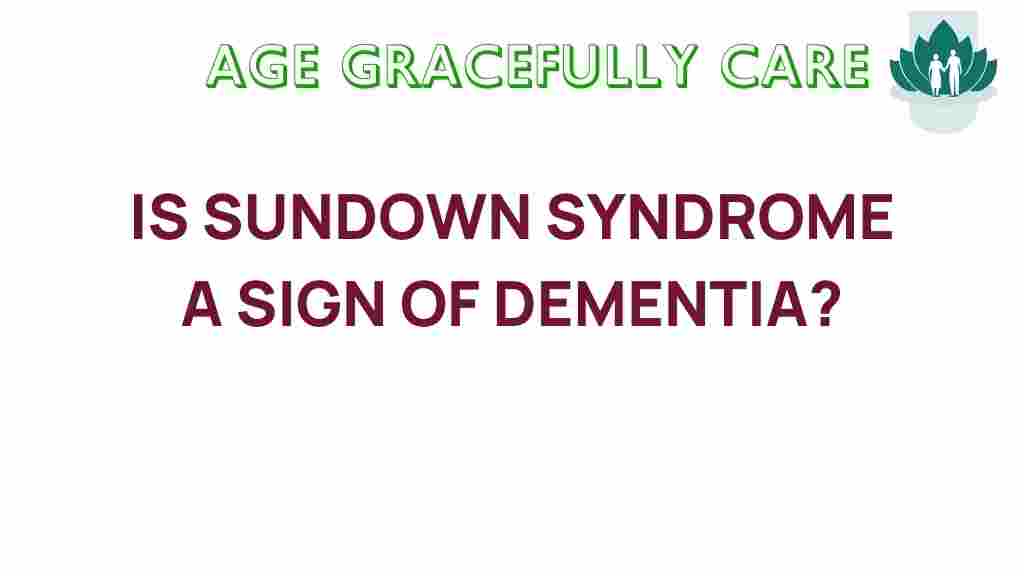Sundown Syndrome: A Sign of Dementia?
As we age, we often face various challenges related to mental health, particularly among the elderly. One such challenge is Sundown Syndrome, a phenomenon that has raised many questions regarding its implications for conditions like dementia. In this article, we will unravel the mystery of Sundown Syndrome, exploring its relationship with dementia, cognitive decline, and its impact on elderly care.
Understanding Sundown Syndrome
Sundown Syndrome, also known as late-day confusion, refers to a pattern of behavioral changes that occur in the late afternoon or early evening. Individuals experiencing this syndrome may exhibit increased confusion, agitation, and anxiety as the sun begins to set. This phenomenon is particularly common among individuals with neurological disorders, including dementia.
What Causes Sundown Syndrome?
The exact cause of Sundown Syndrome is still under investigation, but several factors may contribute to its onset:
- Changes in Light: As daylight decreases, the lack of natural light can lead to feelings of disorientation.
- Fatigue: By the end of the day, many elderly individuals may be overtired, leading to heightened confusion.
- Routine Disruption: Changes in daily routines can exacerbate feelings of anxiety and confusion.
- Environmental Factors: Noisy or chaotic environments during the evening can increase stress levels, triggering episodes of Sundown Syndrome.
The Connection Between Sundown Syndrome and Dementia
Understanding the link between Sundown Syndrome and dementia is crucial for caregivers and families. While Sundown Syndrome is not exclusive to those with dementia, its prevalence is significantly higher among individuals diagnosed with this condition. Here are some key points to consider:
- Cognitive Decline: People with dementia often experience cognitive decline that affects their perception of time and space, making late-day confusion more pronounced.
- Behavioral Changes: Sundown Syndrome is characterized by behavioral changes, which can be particularly alarming for caregivers. Understanding these changes can help in managing care effectively.
- Neurological Disorders: Sundown Syndrome is often observed in individuals with other neurological disorders, indicating a broader spectrum of cognitive challenges.
Identifying Sundown Syndrome in the Elderly
Recognizing the signs of Sundown Syndrome is essential for effective caregiving. Here are some common symptoms to look for:
- Increased agitation or restlessness in the late afternoon
- Confusion concerning time, place, or people
- Changes in mood, such as irritability or sadness
- Difficulty concentrating or completing tasks
- Increased verbal or physical aggression
Step-by-Step Process for Managing Sundown Syndrome
Managing Sundown Syndrome effectively requires a proactive approach. Here’s a step-by-step guide to help caregivers:
Step 1: Create a Calming Environment
Establishing a peaceful and reassuring atmosphere can help reduce the symptoms of Sundown Syndrome. Consider the following:
- Dim the lights in the evening to create a soothing ambiance.
- Reduce noise levels by turning off the television or radio.
- Engage in calming activities such as reading or listening to soft music.
Step 2: Maintain a Consistent Routine
Consistency is key for individuals experiencing cognitive decline. Here are ways to maintain a routine:
- Set regular meal times and stick to them.
- Encourage daily physical activity in the morning or early afternoon.
- Engage in mentally stimulating activities earlier in the day when energy levels are higher.
Step 3: Monitor for Triggers
Identifying specific triggers can help prevent episodes of Sundown Syndrome. Keep track of:
- Environmental changes that coincide with episodes.
- Dietary intake, particularly caffeine and sugar levels.
- Social interactions and their timing throughout the day.
Step 4: Implement Calming Strategies
When symptoms arise, use calming techniques to help manage the situation:
- Practice deep breathing exercises.
- Engage in gentle stretching or relaxation techniques.
- Provide reassurance and comfort through touch or soft spoken words.
Step 5: Seek Professional Guidance
If episodes of Sundown Syndrome persist, consider consulting a healthcare professional. They can provide tailored advice and possible interventions, including medication management if necessary. To learn more about caregiving strategies, visit this resource.
Troubleshooting Tips for Caregivers
Caregiving for someone with dementia who experiences Sundown Syndrome can be challenging. Here are some troubleshooting tips to ease the burden:
- Stay Calm: Your demeanor can significantly influence the individual’s response. Remain calm and composed during episodes.
- Redirect Attention: Gently redirect their focus to a soothing activity or topic of interest.
- Utilize Familiar Items: Familiar objects can provide comfort and a sense of security.
- Keep Communication Simple: Use short, clear sentences to avoid overwhelming them.
When to Seek Help
While managing Sundown Syndrome at home is often feasible, there may be times when external support is needed. Consider seeking help if:
- The individual becomes excessively agitated or aggressive.
- Safety concerns arise, such as wandering or falls.
- Caregiver fatigue sets in, impacting your health and well-being.
Conclusion
In conclusion, while Sundown Syndrome is often associated with dementia, it is essential to understand that it is not a definitive sign of the disease. Awareness of this late-day confusion can enhance the quality of care for the elderly. Recognizing the symptoms, implementing effective management strategies, and remaining vigilant about triggers can significantly improve the experiences of both caregivers and those affected by Sundown Syndrome.
For further reading on cognitive decline and elderly care, check out this informative article. Remember, proactive caregiving can lead to a more peaceful and manageable environment for everyone involved.
This article is in the category Health and created by AgeGracefullyCare Team
